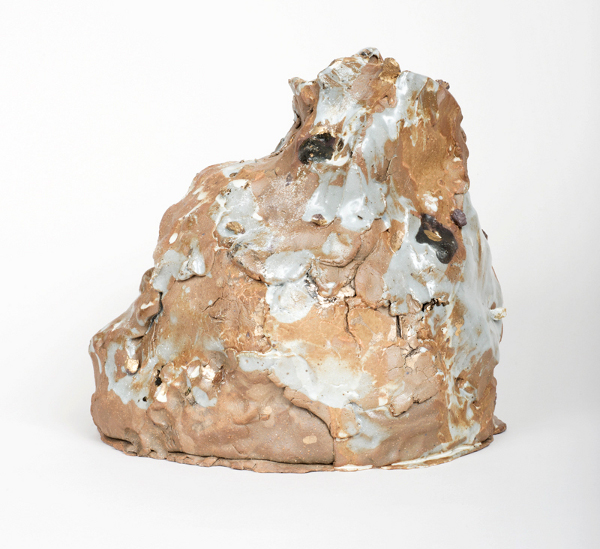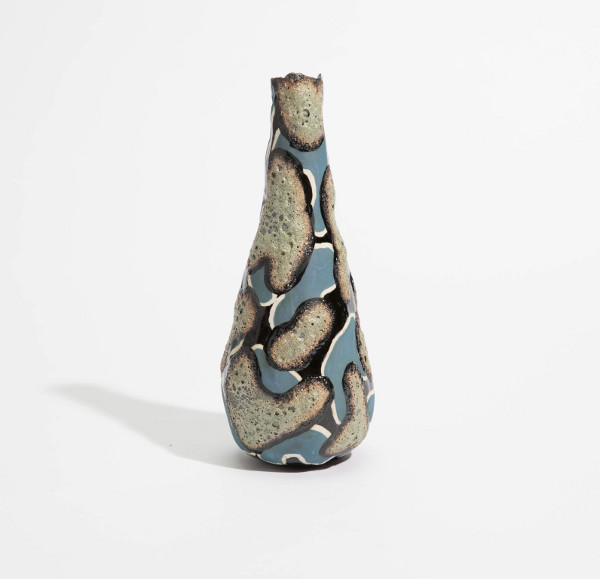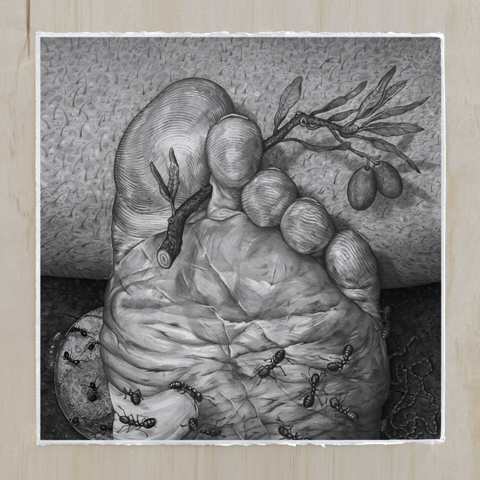
Finding life in the stones at Savery Gallery
If the first floor of 319 N. 11th Street has seemed especially active lately, that’s because the formerly empty street level windows now look in on the brand new Savery Gallery, which opened its doors at the beginning of 2015. For its March exhibition, Savery is featuring a collaborative dialogue between artists Jessica Hans and Miranda Pfeiffer as part of their show, “Cones Look Like Cowled Monks.” Through their media of choice – Pfeiffer uses graphite and printmaking alongside ceramicist Hans’s handmade vessels – the pair react to the natural geological forms of Pasha Baja in Turkey, which are said to resemble hooded monks.
Jessica Hans, “Crag Mountain.” Image courtesy Savery Gallery
Both artists utilize rather tactile approaches, but the porcelain and stoneware creations by Hans directly reflect the three-dimensional wonder of craggy landscapes like Pasha Baja. Although smaller in scale than the hulking formations in Turkey, some of these creations draw directly from visages of mountains, monoliths and coral. Other pieces by Hans are more loosely connected to the stones, sculpted as vases and bowls of varying sizes and dimensions, but even these objects retain an earthly anchor by way of their raw materials and muted glaze colors.
Jessica Hans, “Coral.” Image courtesy Savery Gallery
Asymmetry is key in every one of Jessica Hans’s works. Upon seeing pieces like “Crag Mountain” or “Black Morel,” the rough, jagged shapes are readily apparent, and these substances look like they could have been lifted from a desert valley or an extinct volcano. “Coral” takes a slightly more oceanic path, its peak curling reverently downward as if swaying in the current, and its exterior coated in a pocked, pale blue shell that looks as much organic as it does geological.
Jessica Hans, “Algae Vase.” Image courtesy Savery Gallery
Others like “Large Shadow Bowl” and “Algae Vase” retain elements of traditional ceramics in their similarity to functional pots and pitchers, but lack the perfect curves and geometric components of their more manufactured cousins. Their unevenness is subtle but consistent, and some even contain holes that would preclude their ability to hold liquids. In this way, they are more like rocks than receptacles, and with their thin necks and substantial bodies, sometimes figures as well.
Miranda Pfeiffer, “Antarctica.” Image courtesy Savery Gallery
Miranda Pfeiffer constructs scenes in two dimensions with pencils and prints that allude to not only the physical characteristics of the earth, but their discovery as well. Many times the scenes Pfeiffer imagines seem to have been excavated from – not rendered onto – the surfaces she interacts with. In “Antarctica,” for instance, the human appeal of exploration is the focus as the obscured outline of the inhospitable continent fades into the rear. In each droplet or chunk of ice in the foreground, faces are refracted and distorted, but unmistakable. Each individual bears a stern expression of determination, as well as a certain anonymity in the shadow of the South Pole.
Miranda Pfeiffer, “Facing My Foot.” Image courtesy Savery Gallery
With the precision of an archaeologist, Pfeiffer seems to uncover detailed textures and anthropomorphic likenesses through her additive process. “Facing My Foot” presents an olive branch held aloft by a human foot, a surreal parade of ants marching around its arch. In colorless shades of gray and exaggeratedly rough details, the toes almost seem like a rocky outcropping, and the skin and leg hairs behind them take on the characteristics of sand more than anything living. We ourselves must dig to unearth what the artist sometimes hides in plain sight.
Miranda Pfeiffer, “Tiles.” Image courtesy Savery Gallery
In her prints, Pfeiffer prefers to study texture almost exclusively, spreading out fields of pockmarked, gritty expanses that also verge on life. Like the stony spikes that invoke images of ascetic holy men, the overlapping layers in “Tiles” could either be shale or reptile scales, and the porous holes of “Sponge” could be pumice as easily as the invertebrate of the same name.
Personifying the environment either by way of what we make or what we’re made of is a trait we often take for granted. While some might write off seeing faces in the stones as a false perception, others turn this ability into inspiration. “Cones Look Like Cowled Monks” will be on display through March 31.
Savery Gallery is located at 319 N. 11th St., Philadelphia; [email protected]; saverygallery.com.
Recent Content
-
Artsarticle ·
-
Artsarticle ·
-
Artsarticle ·





